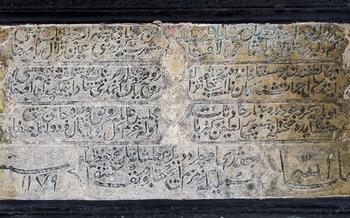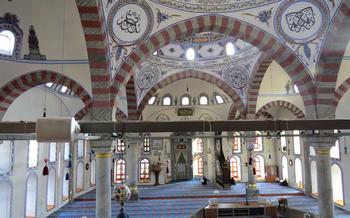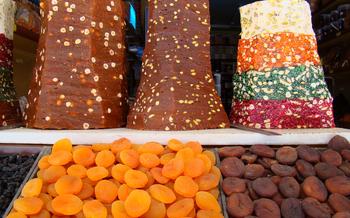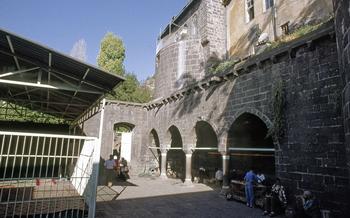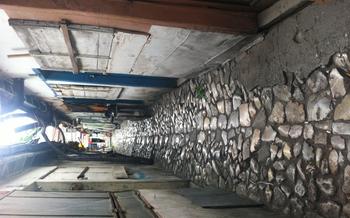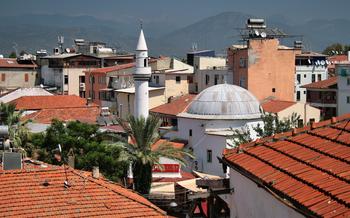
Aslanapa Ulu Mosque
- The Antiquity of Aslanapa Ulu Mosque
- A Centerpiece of Kütahya:
- Journey Through Time
- A Blend of Architectural Styles
- Exploring the Mosque's Interior
- Dome and Minaret Masterpieces
- Calligraphic Delights
- Stories from the Walls:
- Embrace the Spirituality
- A Place of Learning and Community
- Witness the Call to Prayer
- Capture the Essence of Kütahya
- Local Delights: Savoring the Flavors of Kütahya
- Respectful Etiquette
- Insider Tip: Unearth Hidden Treasures Nearby
The Antiquity of Aslanapa Ulu Mosque
The Aslanapa Ulu Mosque, a venerable edifice in the heart of Kütahya, Turkey, stands as a testament to the city's rich historical tapestry. Its construction dates back to the 14th century, during the reign of the Anatolian Beyliks, who played a pivotal role in shaping the region's cultural and architectural landscape. The mosque's architectural style reflects the distinct Seljuk influences prevalent at the time, characterized by intricate stonework, elegant arches, and a harmonious blend of geometric and floral motifs. Aslanapa Ulu Mosque is not merely a place of worship but a repository of cultural legacy, embodying the region's artistic traditions and serving as a tangible reminder of its storied past.
Several key events have transpired within the mosque's hallowed walls, contributing to its historical significance. In the 16th century, during the Ottoman era, the mosque underwent extensive renovations and additions, reflecting the changing architectural tastes and the growing influence of the Ottoman Empire. These renovations included the construction of the imposing minaret, which became a defining feature of the mosque's skyline. Over the centuries, the mosque has borne witness to the ebb and flow of history, serving as a sanctuary for the local Muslim community and a gathering place for religious and social events.
A Centerpiece of Kütahya:
The Aslanapa Ulu Mosque stands as a prominent landmark in the heart of Kütahya, symbolizing the city's rich heritage and religious devotion. Its strategic location on a hill overlooking the city makes it a visible and awe-inspiring presence, drawing the eyes of locals and visitors alike. The mosque's grand architecture and intricate details reflect the city's history, culture, and religious significance, serving as a testament to the enduring legacy of Islamic architecture in Turkey.
As a symbol of Kütahya, the Aslanapa Ulu Mosque holds a special place in the hearts of the city's residents. It represents the deep-rooted faith and devotion of the Muslim community, serving as a place of worship, reflection, and spiritual connection. The mosque's presence has shaped the city's identity and continues to be an integral part of its cultural fabric, attracting visitors from near and far who come to admire its beauty, learn about its history, and experience the spiritual ambiance that permeates its walls.
Journey Through Time
The construction of the Aslanapa Ulu Mosque unfolded over a series of centuries, each leaving its own distinct mark on the mosque's architectural tapestry. The initial foundations were laid in the 13th century during the reign of the Seljuk Sultanate, with the mosque taking shape as a classic example of Seljuk architecture. As centuries passed, the mosque underwent several transformations, reflecting the changing political and cultural landscapes of Anatolia.
In the 15th century, during the early Ottoman period, the mosque was expanded and renovated under the patronage of the Ottoman Sultan Murad II. This period saw the addition of the impressive domed section, giving the mosque its characteristic grandeur. The Ottomans also made significant modifications to the interior, introducing intricate ornamental elements and Kufic inscriptions that showcased their refined artistic sensibilities.
Over the years, the mosque has undergone several restoration efforts to preserve its architectural integrity and maintain its functionality as a place of worship. These efforts have been meticulously carried out, ensuring that the mosque's historical significance and unique features are safeguarded for generations to come.
A Blend of Architectural Styles
Aslanapa Ulu Mosque stands as a testament to the fusion of Seljuk and Ottoman architectural styles, showcasing a remarkable synthesis of two distinct eras. The mosque's foundations were laid during the Seljuk period, evident in its intricate stonework and geometric patterns. These elements harmoniously blend with later Ottoman additions, such as the elegant dome and minaret, which exhibit a more refined and ornate style.
The mosque's facade, adorned with stunning Seljuk-era stone carvings, narrates tales of history and artistry. These intricate embellishments depict various motifs, including geometric patterns, stylized plant forms, and Kufic inscriptions that add a touch of grandeur to the mosque's exterior. The rhythmic repetition of these decorative elements creates a captivating visual symphony, inviting visitors to delve deeper into the mosque's architectural wonders.
Inside the mosque, the Ottoman influence becomes more pronounced. The graceful dome, a hallmark of Ottoman architecture, dominates the interior space, creating a sense of awe and tranquility. Its intricate geometric patterns and vibrant colors captivate the eye, drawing visitors' attention upwards towards the heavens. The slender minaret, adorned with intricate tilework and delicate balconies, stands as a symbol of the mosque's spiritual significance and serves as a beacon of faith, guiding the faithful towards the path of devotion.
The Aslanapa Ulu Mosque, with its harmonious blend of Seljuk and Ottoman architectural elements, stands as a living testament to the rich cultural heritage of Turkey. It embodies the fusion of two distinct eras, creating a masterpiece that transcends time and continues to inspire and captivate visitors from around the world.
Exploring the Mosque's Interior
Delving into the heart of the Aslanapa Ulu Mosque reveals a mesmerizing fusion of architectural and spiritual elements. The main prayer hall, with its towering columns and intricate arches, exudes a sense of grandeur and serenity. The mihrab, the sacred niche indicating the direction of Mecca, stands as a focal point, adorned with exquisite tilework and carvings that showcase the artistry of its creators.
The minbar, a pulpit from which sermons are delivered, is an impressive sight, handcrafted from intricately carved wood, reflecting the mosque's rich heritage. Other notable features include the qibla wall, adorned with verses from the Quran, and the stained glass windows, which cast a warm, ethereal glow upon the interior. Each element within the mosque harmoniously blends to create a space of spiritual contemplation and connection with the divine.
Dome and Minaret Masterpieces
The dome of Aslanapa Ulu Mosque stands as a testament to the architectural prowess of its builders. Constructed using the traditional brick-and-mortar technique, the dome exhibits intricate patterns and geometric designs. Its interior is adorned with colorful tiles and Kufic inscriptions, adding to its visual splendor. The dome's remarkable acoustics create a reverberating effect, amplifying the voices of the muezzin during the call to prayer.
The minaret of the mosque is equally impressive, rising high above the city skyline. Its slender cylindrical form is topped by a conical roof, adorned with decorative elements. The minaret's intricate brickwork and carved stonework showcase the craftsmanship of the era. Its height and visibility serve as a beacon, guiding the faithful towards the mosque and symbolizing the importance of Islam in the city.
Together, the dome and minaret of Aslanapa Ulu Mosque create a harmonious silhouette that dominates the cityscape. They stand as symbols of architectural ingenuity and the enduring legacy of the Seljuk and Ottoman empires.
Calligraphic Delights
The Aslanapa Ulu Mosque is a treasure trove of calligraphic artistry, showcasing the exquisite craftsmanship of Islamic calligraphy. Kufic inscriptions, characterized by their angular and geometric forms, adorn the mosque's walls and mihrab, adding a touch of grandeur and solemnity. Verses from the Quran, carefully inscribed in elegant Arabic script, serve as reminders of the mosque's religious significance and provide a visual testament to the artistry of the calligraphers. Ornamental calligraphy, with its intricate patterns and flourishes, further enhances the mosque's interior, creating a harmonious blend of art and devotion. Exploring the mosque's calligraphic delights offers a glimpse into the rich tradition of Islamic calligraphy, where words become both a form of worship and an art form.
Stories from the Walls:
Aslanapa Ulu Mosque stands as a testament to the rich cultural heritage of Kütahya, and its walls silently narrate captivating stories through their intricate tiles and decorative elements. Each tile, meticulously crafted and arranged, holds profound symbolism and meaning, reflecting Anatolian culture and the artistry of skilled craftsmen.
The mosque's interior is adorned with stunning tiles, each telling a unique tale. Geometric patterns, floral motifs, and verses from the Quran dance across the walls, creating a mesmerizing visual symphony. The tiles serve as a reminder of the deep-rooted Islamic traditions that have shaped Kütahya's identity.
One of the most striking features of the mosque is its tilework depicting scenes from everyday life in Anatolia. These tiles offer a glimpse into the customs, traditions, and occupations of the people who lived in the region centuries ago. From depictions of farmers tending to their fields to merchants engaged in trade, the tiles provide a vibrant and immersive portrayal of Anatolian life.
As you explore the mosque's walls, you'll discover hidden symbols and motifs that hold deep cultural significance. The tulip, a symbol of love and beauty, is a recurring motif, while the crescent moon and star, representing Islam, are prominently displayed. These symbols, woven into the fabric of the mosque's design, serve as reminders of the rich tapestry of beliefs and traditions that have shaped Kütahya's past and present.
Through its captivating tiles and decorative elements, Aslanapa Ulu Mosque invites visitors to embark on a journey of discovery, delving into the depths of Anatolian culture and Islamic heritage. Each tile, a masterpiece in its own right, tells a story, revealing the artistry, craftsmanship, and profound symbolism that have made this mosque a beloved landmark in Kütahya.
Embrace the Spirituality
The Aslanapa Ulu Mosque is not just a magnificent architectural marvel; it is also a living testament to the deep spiritual significance it holds for the Muslim community. As a place of worship, the mosque exudes a palpable aura of tranquility and devotion. Worshippers gather here to offer their prayers, seeking solace and connection with the divine. The harmonious recitation of verses from the Quran fills the air, creating a mesmerizing symphony of faith.
For visitors, stepping into the mosque is an opportunity to witness the profound spirituality that permeates every corner. The intricate details, the ornate calligraphy, and the serene ambiance combine to create an environment that invites contemplation and reflection. Whether observing the rituals of prayer or simply absorbing the spiritual energy, visitors can't help but feel a sense of awe and reverence.
The mosque's role as a spiritual center extends beyond its walls. It serves as a gathering place for the Muslim community, fostering a sense of unity and belonging. Religious festivals and celebrations are held here, bringing together people from all walks of life to share in the joy and camaraderie of their faith.
For those seeking a deeper understanding of Islam, the Aslanapa Ulu Mosque offers a glimpse into the rich traditions and practices of the religion. Visitors can witness the daily rituals, learn about the significance of various Islamic symbols and customs, and engage in meaningful conversations with members of the community.
A Place of Learning and Community
Beyond its religious significance, the Aslanapa Ulu Mosque served as a hub of knowledge and community engagement. It housed a madrasah, an Islamic school, where students gathered to study religious texts, Arabic language, and various branches of Islamic sciences. The mosque's serene atmosphere and learned scholars attracted students from across the region, fostering an environment of intellectual exchange and spiritual growth.
The mosque also played a vital role in strengthening community bonds. It hosted social and cultural gatherings, where people from different walks of life came together to celebrate religious festivals, share stories, and discuss matters of community interest. These gatherings fostered a sense of unity and belonging, reinforcing the mosque's position as the heart of the Kütahya community.
Witness the Call to Prayer
The Aslanapa Ulu Mosque resounds with the melodious call to prayer five times a day, echoing through the streets of Kütahya and inviting the faithful to congregate for their prayers. The Adhan, or call to prayer, is a beautiful and evocative chant that holds a deep significance in Islamic tradition.
Performed by the muezzin, a designated caller, the Adhan is recited from the minaret, the tall, slender tower that rises gracefully from the mosque's structure. The muezzin's voice, amplified by the acoustics of the minaret, carries across the city, summoning the Muslim community to come together for their religious obligations.
The Adhan serves as a reminder of the importance of prayer in Islam, calling upon the believers to turn their hearts and minds towards God. It is a poignant moment that creates a spiritual connection between the mosque and the surrounding community, transcending linguistic and cultural barriers.
As a visitor, witnessing the call to prayer at the Aslanapa Ulu Mosque is a unique and moving experience. It offers a glimpse into the vibrant Islamic traditions that permeate the city of Kütahya and allows you to connect with the profound spirituality that emanates from this historic place of worship.
Capture the Essence of Kütahya
The Aslanapa Ulu Mosque, with its exquisite details and striking presence, is a gem waiting to be captured through the lens. As you explore the mosque, take your time to appreciate the intricate tile work, the graceful arches, and the ornate calligraphy that adorn its walls. Experiment with different angles and lighting conditions to capture the mosque's grandeur and serenity. Remember to respect the sanctity of the mosque and avoid disturbing worshippers during prayer times. Share your captured moments with the world, allowing others to experience the beauty and history of this architectural masterpiece. Your photographs will not only serve as cherished memories but also contribute to the preservation and promotion of Kütahya's rich cultural heritage.
Local Delights: Savoring the Flavors of Kütahya
No trip to Kütahya is complete without indulging in the city's culinary delights. As you wander through the charming streets, you'll find an array of traditional Turkish restaurants and local eateries serving up mouthwatering dishes.
For a taste of authentic Turkish cuisine, don't miss the opportunity to try mantı, a traditional Turkish dumpling dish. These small, ravioli-like dumplings are filled with a savory meat or vegetarian mixture and topped with a yogurt sauce, garlic, and paprika. Another local specialty is gözleme, a type of flatbread filled with various ingredients such as cheese, spinach, or minced meat.
As you explore the city, keep an eye out for the local market, where you can find fresh produce, spices, and traditional Turkish sweets. Treat yourself to some lokum, also known as Turkish delight, a sweet, chewy confection made with sugar, starch, and rosewater.
In Kütahya, supporting the local economy is easy. By dining at local restaurants, shopping at the market, and exploring the city's hidden gems, you're not only experiencing the authentic flavors of Kütahya but also contributing to the community's well-being.
Remember, the best way to experience Kütahya's culinary scene is to embrace the local culture and traditions. Ask for recommendations, try new dishes, and don't be afraid to venture off the beaten path. With so much to offer, Kütahya is a foodie's paradise waiting to be explored.
Respectful Etiquette
The Aslanapa Ulu Mosque, like any other religious site, holds great significance for the local Muslim community and demands respectful behavior from visitors. To ensure a harmonious and enriching experience, it is essential to adhere to certain etiquette guidelines.
Modest Attire: When visiting the mosque, it is customary to dress modestly. This means avoiding revealing or tight-fitting clothing, especially for women. Covering your shoulders, knees, and chest is considered respectful.
Footwear Etiquette: Before entering the prayer hall, it is customary to remove your shoes and place them neatly on the designated shelves or racks. This is a sign of respect for the cleanliness and sanctity of the mosque.
Silence and Reverence: The mosque is a place of worship and contemplation. Maintaining silence and refraining from loud conversations or disruptive behavior is essential. Respect the serene atmosphere and avoid disturbing the worshippers.
Local Customs and Traditions: When visiting the mosque, it is important to be mindful of local customs and traditions. For example, during prayer times, it is customary to stand up and face the direction of Mecca (Qibla) if you are a Muslim. If you are not a Muslim, it is advisable to observe quietly from a distance.
By following these simple guidelines, you can demonstrate respect for the religious and cultural significance of the Aslanapa Ulu Mosque and enhance your overall experience.
Insider Tip: Unearth Hidden Treasures Nearby
As you delve into the history and beauty of the Aslanapa Ulu Mosque, don't miss the opportunity to explore the captivating historical sites that lie within easy reach. Embark on a journey to uncover the ancient ruins, intriguing museums, and architectural wonders that dot the landscape of Kütahya.
-
Kütahya Castle: Perched atop a hill overlooking the city, Kütahya Castle stands as a testament to the region's rich past. Explore its fortifications, admire the panoramic views, and immerse yourself in the tales of battles and conquests that shaped its history.
-
Germiyan Museum: Step into the Germiyan Museum to discover a treasure trove of artifacts that illuminate the legacy of the Germiyan Beylik, a powerful Anatolian dynasty that ruled over Kütahya for centuries. Marvel at intricate pottery, exquisite carpets, and historical documents that bring the past to life.
-
Kütahya Archeological Museum: Embark on a journey through the ages at the Kütahya Archeological Museum. Unearth the secrets of ancient civilizations that flourished in this region, from the Phrygians to the Romans. Admire artifacts that showcase the artistry, ingenuity, and cultural heritage of Kütahya's past.
-
Tavşanlı Bazaar: Immerse yourself in the vibrant tapestry of Turkish culture at the Tavşanlı Bazaar. Wander through a maze of stalls offering an array of traditional handicrafts, textiles, and local delicacies. Experience the warmth of Turkish hospitality as you haggle for treasures and discover unique souvenirs to cherish.
Prepare to be captivated as you delve into the historical depths of Kütahya, where every stone holds a story and every corner reveals a hidden gem.
